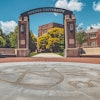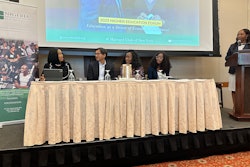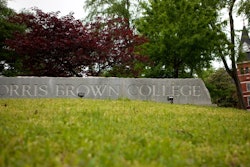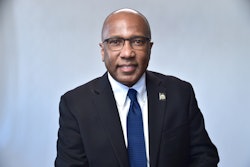Riding the High Tide
India has surpassed China as the leading sender of foreign students to the United States, so why are its students increasingly drawn to U.S. universities?
By Shilpa Banerji


When 24-year-old Anil Mukherji joined Louisiana State University as a postdoctoral research assistant in chemistry in 1957, he was one of four Indians in the school. More than four decades later, in 2003, LSU’s Indian Student Association, one of the largest student communities in Baton Rouge, claims to have 465 members.
Indians have always viewed the United States as the Mecca of higher education, so it is no surprise that the numbers of Indian students pursuing their degrees at American institutions has dramatically increased over the years. Though traditional English institutions such as the Universities of Oxford and Cambridge fascinated the educated elite in the former British colony, opportunities for research-oriented subjects in the math and science fields have long attracted Indians to American universities.
According to the International Institute of Education (IIE), India’s enrollment rates have followed the larger Asian trend over the past 40 years, with several thousand students coming each year to pursue higher education. The numbers of Indian students attending U.S. institutions of higher education first peaked in 1992 and then gradually declined in 1996. However, since 1997, the number of students has dramatically increased. With a massive boost of 22 percent in 2002, or a total of 66,836 students out of 582,996 international students, India has surpassed China as the leading sender of foreign students to the United States for the first time. In 2002, China sent 63,211 students, an increase of only 6 percent.
“Since the Kennedy days, the U.S. was like a dreamland for us. To go to graduate school here was the coolest thing to do at that time,” says Samir Banerji, an engineer with Caterpillar Inc., and a 1967 alumnus of the prestigious Indian Institute of Technology at Kanpur, India (see sidebar).
Armed with a full scholarship from Stony Brook University in metallurgy and metal sciences, Banerji finished his doctorate in 1973 and went on a nine-month stint as a visiting scientist to Italy before returning to the United States as a postdoctoral research fellow at the Massachusetts Institute of Technology and the University of Pennsylvania.
Like Banerji, Mukherji had similar reasons for continuing his education in the United States, in addition to receiving a fellowship from his professor at LSU.
“American education is more application-oriented. The Indian system was a bad copy of the British and quite irrelevant,” says Mukherji, a former executive at Xerox.
The New Generation
The reasons for coming to study in the United States are the same for Indian students — even 40 years later. Students have high expectations of an American education and expect to gain more opportunities as well as a new perspective.
In 2001-2002 the U.S. Education Foundation in India (USEFI) made approximately 320,000 contacts via phone, e-mail and in-person visits with aspiring students who were interested in going to the United States. Indian students have been mostly undeterred by the Sept. 11 terrorist attacks, and in the past two years, approximately 20,000 students were issued F-1 or student visas by the U.S. Embassy.
“The variety and flexibility of the American education system is the most appealing factor to Indian students,” says Dr. Vijaya Khandavilli, an adviser with USEFI. “Engineering, math, business and computer science are the most popular fields of study but there are some who are interested in off-beat programs like film production and communications.”
Though most applications are for graduate schools, Khandavilli points out that the number of applicants for undergraduate studies is slowly rising.
“A four-year education is very expensive, and funding is difficult at the undergraduate level. Besides, many parents are still apprehensive about sending their 17-year-olds to far-off destinations,” Khandavilli says.
Dr. Allan E. Goodman, president of IIE, says the prosperous and increasing Indian middle class want their children to have the best education.
“When America’s middle class was growing, they bought homes, cars and television sets. Families in India and China put a tremendous amount of investment in education,” Goodman says.
Overpopulation in both Asian countries also have forced students to look elsewhere. “They can’t build universities fast enough or train enough faculty,” adds Goodman. “It becomes very competitive and parents value education enough to seek the best for their child.”
Chhavi Sachdev and Sharad Ghosh, both 26, were two students who left the safe confines of their homes in India for the United States to pursue undergraduate degrees.
“At 17, I didn’t want to be constricted,” says Sachdev, a media professional in Boston, who graduated from King College in Bristol, Tenn. “There is quality education in India but it didn’t suit me. It’s deep, as opposed to broad here. I wanted a liberal arts education which would allow me to explore my options.” Sachdev majored in psychology and also took piano lessons and classes in literature and German.
Ghosh, a management executive living in New York City, dabbled in various courses from wine tasting to classes in African history, while pursuing a major in mechanical engineering at the University of Rochester before transferring to Cornell University.
“I loved my undergrad program. It helped me grow as a person. And it was important not to feel tied down to one particular thing,” he says. “I enjoyed learning ballroom dancing as much as I did quantum physics.”
For graduate students with work experience, the challenge and excitement to learn in a diverse environment presents an opportunity of a lifetime.
Swamynarayan Sampath, a 27-year-old management executive from Kolkata, India, says it was an easy decision to enter the MBA program at Boston University, in a city that’s rich in history, education and job opportunities.
“I needed the international experience, where professors have more experience and the focus is on raw skills,” Sampath says.
Karthik Sundaramoorthy, a former IBM executive from Bangalore, the southern city in the heart of what is known as India’s Silicon Valley, came to North Carolina State University in Raleigh to pursue a master’s in computer engineering.
“I knew IBM had its headquarters here, and the best way to get employed in the U.S. is to have a degree from here,” Sundaramoorthy says. Now, finishing his doctorate, he has no regrets. “The research labs have state-of-the-art equipment. It would have been very difficult for any school in India to procure them unless it’s a big research establishment.”
The quality of research is perhaps one of the main reasons why students eye schools in the United States.
Arjun Deb, a medical resident at the Mayo School of Medicine in Rochester, Minn., is the only Indian in his graduating class. “I could go home to India and set up my practice,” says Deb, 30. “The only reason I’m here is for a solid, research-based career.”
Returning to India
Going home is something many Indian students are grappling with these days. When Mukherji and Banerji came to the United States in the 1950s and ’60s, their education gave them a foundation to an American way of life and provided a better future for their children. They were part of the so-called “brain drain.”
“That (brain drain) is just a fashionable thing to talk about in cushy parlors,” says Banerji, a distant relative of the author. “Nothing was done to reverse it.”
The independent, creative and talented graduates were not appreciated in the Indian context of time, he adds, and even with the brain drain, India gained tremendously in later years through foreign currency remittances and intellectual inputs from expatriates, many of whom hold influential positions in multinational companies today. However, with the opening of markets in the early ’90s, returning to Indian shores is an option many students are not readily discounting as in previous years.
Ghosh, Sachdev and Sampath are climbing the American corporate ladder and plotting their return to India — eventually.
“Going to college here is a privilege,” Sachdev says. “People view it as an investment, and it has taught me to think critically and deal with different kinds of people. I’d like to take back what I learned and be in my own country.”
Adds Sampath: “There are so many Western companies coming to India and they have a hard time understanding our culture. With my work experience here, I can go back and bridge the gap for them.”
Others, like Soondaramurthy and Anil John Saldhana know and understand the need for Indian software professionals.
“It’s like a cycle that keeps changing over the years,” Soondaramurthy says. “You don’t know how many will actually stick on for good. I’d love to return only because my family is there. If I could afford to have them visit me, it wouldn’t matter where I am.”
Saldhana, who came to pursue a master’s in computer engineering at the University of Illinois, says, “The brain drain is still happening. If there is improvement in infrastructure and socio-cultural advancement, I will return.”
The choice to return to India will, however, remain a personal and individual one. But the decision to study in the United States is not a difficult one to make — especially if students receive financial assistance from a top university.
“Was Dr. Kalpana Chawla a brain drain,” says Mukherji of the Indian-born astronaut killed in the recent shuttle tragedy. “She would not have accomplished what she had if she had not come here and that is a tribute to her and to this country.”
— Shilpa Banerji, a native of New Delhi, India, is a graduate of the University of Delhi. She received her master’s in journalism from Boston University in 2003. She is also on the staff of Black Issues In Higher Education and Community College Week.
© Copyright 2005 by DiverseEducation.com





















